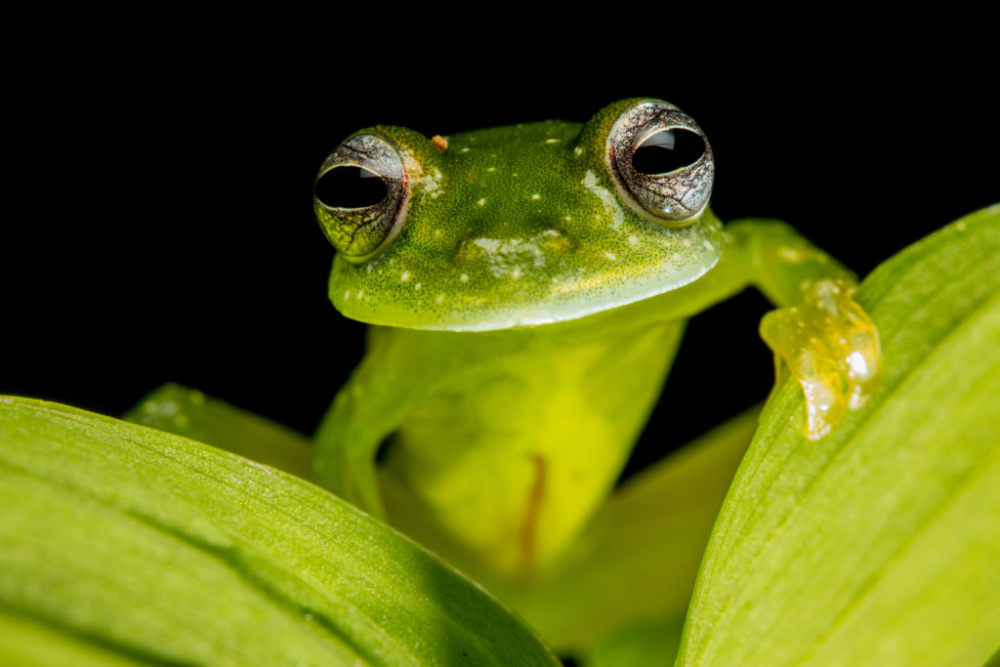Physical Characteristics
The most striking feature of glass frogs is their translucent skin. This transparency can be so pronounced that in some species, the bones, intestines, and even the beating heart are visible through the skin. This adaptation is believed to play a role in camouflage, making the frogs harder to detect by predators from below.
Glass frogs are relatively small, generally ranging from 1.2 to 3 inches (3 to 7.5 cm) in length. Their dorsal side typically displays a range of green hues, which helps them blend into their leafy surroundings. The green coloration is often adorned with yellow or white spots, further aiding in their camouflage.
Habitat and Distribution
Glass frogs are predominantly found in the tropical rainforests of Central and South America, with their range extending from southern Mexico to Panama, and from Colombia to Bolivia and Venezuela. They thrive in humid, montane forests, particularly in regions close to streams and rivers where they can lay their eggs.
Behavior and Ecology
Glass frogs are primarily nocturnal creatures, spending their nights foraging for food and engaging in reproductive activities. During the day, they remain hidden on the undersides of leaves, where their transparency offers protection from predators.
The diet of glass frogs consists mainly of small insects and other invertebrates. They use their keen eyesight and agility to capture prey, often leaping from leaf to leaf in pursuit of a meal.

Reproduction
Reproduction in glass frogs is a fascinating process. Males typically call from the undersides of leaves to attract females. These calls can vary in pitch and intensity, with each species having its own distinct call. Once a female is attracted, the male will grasp her in a process known as amplexus. The female then lays her eggs on the underside of a leaf overhanging water, and the male fertilizes them externally.
One of the unique aspects of glass frog reproduction is the parental care exhibited by males. In many species, the male remains with the eggs, guarding them from predators and ensuring they remain moist until they hatch. This behavior increases the likelihood of survival for the offspring, which drop into the water below upon hatching, beginning their aquatic larval stage.
Conservation Status
Many species of glass frogs are facing threats due to habitat loss, climate change, and pollution. Deforestation for agriculture, logging, and human settlement is a significant threat, as it leads to the destruction of the frogs’ natural habitat. Additionally, changes in climate can affect the availability of suitable breeding sites and alter the delicate balance of their ecosystems.
Conservation efforts are underway to protect these unique amphibians. This includes the establishment of protected areas, reforestation projects, and research initiatives aimed at understanding the ecological needs of glass frogs. Public awareness campaigns also play a crucial role in highlighting the importance of preserving these fragile ecosystems.
Scientific Significance
Glass frogs offer valuable insights into a variety of scientific fields, including ecology, evolutionary biology, and physiology. Their unique transparency provides a natural model for studying internal anatomy and physiological processes without invasive procedures. Additionally, understanding the ecological roles of glass frogs can shed light on the health and dynamics of tropical rainforest ecosystems.
Conclusion
Glass frogs are a testament to the wonders of evolution and the intricate beauty of the natural world. Their delicate transparency, fascinating reproductive behaviors, and crucial ecological roles make them a subject of endless fascination and study. As we continue to learn more about these remarkable creatures, it is essential to also focus on their conservation, ensuring that future generations can marvel at the translucent beauty of the glass frog. Through concerted conservation efforts and ongoing scientific research, we can help protect these extraordinary amphibians and the rich biodiversity of the rainforests they inhabit.









